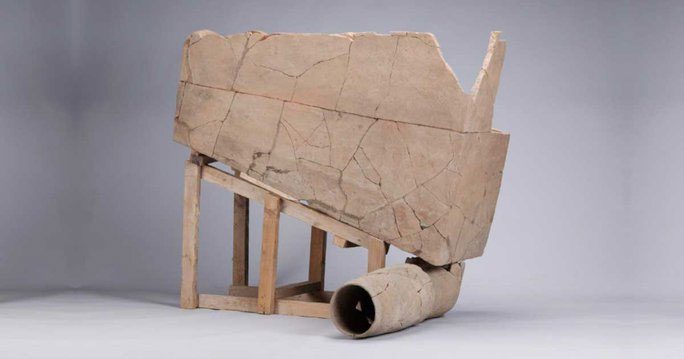Archaeologists have discovered an ancient water-flushed toilet built inside a house, complete with a pipe leading to an outdoor pit, potentially used during the Qin or Han Dynasties.
According to a report by Ancient Origins on February 18, archaeologists excavated the lower half of a 2,400-year-old hand-flushed toilet at the Yueyang archaeological site in Shaanxi Province, China. Yueyang served as the capital of the Qin Dynasty for about 35 years and was also the first capital of the Han Dynasty.

Damaged parts of the toilet, including a curved pipe, excavated from the Yueyang archaeological site in Xi’an, Shaanxi Province. (Photo: China Daily).
The team of experts believes this toilet was used by individuals of high status, such as Qin Xiaogong (381 – 338 BC) or his father (424 – 362 BC) during the Warring States Period (475 – 221 BC), or even Liu Bang (206 BC – 220), the first emperor of the Han Dynasty.
“This is the first and only water-flushed toilet ever excavated in China. Everyone at the site was surprised and then burst into laughter. The toilet provides authentic evidence of the importance of sanitation to ancient Chinese people,” said Liu Rui, an archaeologist at the Archaeological Institute of the Chinese Academy of Social Sciences.
This new discovery sheds light on the technological advancements of the Qin and Han Dynasties. The construction and use of a water-flushed toilet required knowledge of water supply, waste management, and sanitation—concepts that were not common during this period. The discovery also offers insights into the daily lives of high-status individuals living in palaces, who had access to such luxurious amenities.
Researchers have not yet found the upper half of the toilet, so it remains unclear whether users needed to squat or sit. The toilet was located indoors with a pipe leading to an outdoor pit. Servants could pour water into it each time it was used, according to Liu. Indoor toilets were not common during that era, and the use of such facilities may have been limited to a small segment of the population.
The archaeological team is also analyzing soil samples taken from the excavation area. These samples could reveal information about the diet and health of the toilet users. The analysis of these materials may also provide details about agricultural activities and the use of fertilizers. “In addition to recorded texts, we can learn more about social reforms and the systems of the kingdom through further studies of ancient palaces,” Liu added.
This new finding in China is significant because previously, the first manual water-flushed toilet was typically credited to John Harington, who invented it for Queen Elizabeth I in the 16th century.





















































